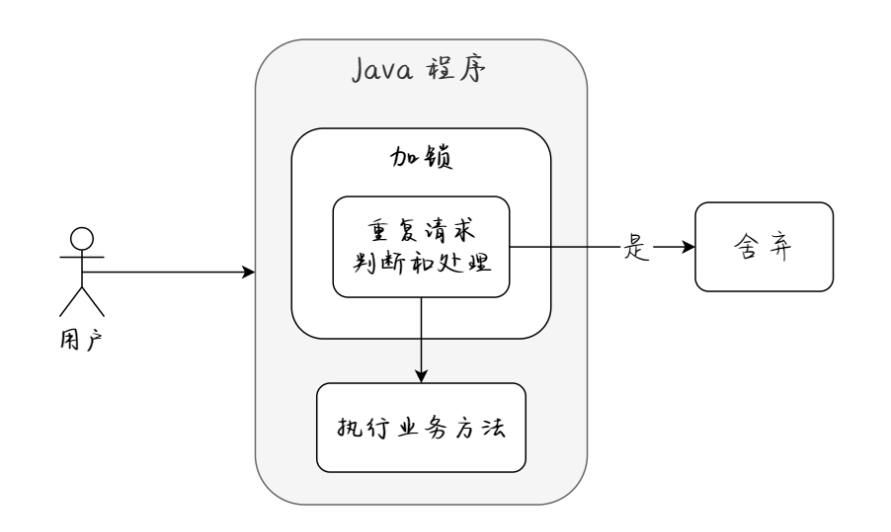如何防止重复提交
前端拦截
前端拦截是指通过 HTML 页面来拦截重复请求,比如在用户点击完“提交”按钮后,我们可以把按钮设置为不可用或者隐藏状态。
代码:
1 2 3 4 5 6 7 8 9 10 11 12 13 14 <html> <script> function subCli(){ // 按钮设置为不可用 document.getElementById("btn_sub").disabled="disabled"; document.getElementById("dv1").innerText = "按钮被点击了~"; } </script> <body style="margin-top: 100px;margin-left: 100px;"> <input id="btn_sub" type="button" value=" 提 交 " onclick="subCli()"> <div id="dv1" style="margin-top: 80px;"></div> </body> </html>
但前端拦截有一个致命的问题,如果是懂行的程序员或非法用户可以直接绕过前端页面,通过模拟请求来重复提交请求,比如充值了 100 元,重复提交了 10 次变成了 1000 元(瞬间发现了一个致富的好办法)。
所以除了前端拦截一部分正常的误操作之外,后端的拦截也是必不可少。
后端拦截 后端拦截的实现思路是在方法执行之前,先判断此业务是否已经执行过,如果执行过则不再执行,否则就正常执行。
我们将请求的业务 ID 存储在内存中,并且通过添加互斥锁来保证多线程下的程序执行安全,大体实现思路如下图所示:
然而,将数据存储在内存中,最简单的方法就是使用 HashMap 存储,或者是使用 Guava Cache 也是同样的效果,但很显然 HashMap 可以更快的实现功能,所以我们先来实现一个 HashMap 的防重(防止重复)版本。
1.HashMap 1 2 3 4 5 6 7 8 9 10 11 12 13 14 15 16 17 18 19 20 21 22 23 24 25 26 27 28 29 30 31 32 33 34 35 import org.springframework.web.bind.annotation.RequestMapping; import org.springframework.web.bind.annotation.RestController; import java.util.HashMap; import java.util.Map; /** * 普通 Map 版本 */ @RequestMapping("/user") @RestController public class UserController3 { // 缓存 ID 集合 private Map<String, Integer> reqCache = new HashMap<>(); @RequestMapping("/add") public String addUser(String id) { // 非空判断(忽略)... synchronized (this.getClass()) { // 重复请求判断 if (reqCache.containsKey(id)) { // 重复请求 System.out.println("请勿重复提交!!!" + id); return "执行失败"; } // 存储请求 ID reqCache.put(id, 1); } // 业务代码... System.out.println("添加用户ID:" + id); return "执行成功!"; } }
存在的问题 :此实现方式有一个致命的问题,因为 HashMap 是无限增长的,因此它会占用越来越多的内存,并且随着 HashMap 数量的增加查找的速度也会降低,所以我们需要实现一个可以自动“清除”过期数据的实现方案。
2.优化版——固定大小的数组 此版本解决了 HashMap 无限增长的问题,它使用数组加下标计数器(reqCacheCounter)的方式,实现了固定数组的循环存储。
当数组存储到最后一位时,将数组的存储下标设置 0,再从头开始存储数据,实现代码如下:
1 2 3 4 5 6 7 8 9 10 11 12 13 14 15 16 17 18 19 20 21 22 23 24 25 26 27 28 29 30 31 32 33 import org.springframework.web.bind.annotation.RequestMapping; import org.springframework.web.bind.annotation.RestController; import java.util.Arrays; @RequestMapping("/user") @RestController public class UserController { private static String[] reqCache = new String[100]; // 请求 ID 存储集合 private static Integer reqCacheCounter = 0; // 请求计数器(指示 ID 存储的位置) @RequestMapping("/add") public String addUser(String id) { // 非空判断(忽略)... synchronized (this.getClass()) { // 重复请求判断 if (Arrays.asList(reqCache).contains(id)) { // 重复请求 System.out.println("请勿重复提交!!!" + id); return "执行失败"; } // 记录请求 ID if (reqCacheCounter >= reqCache.length) reqCacheCounter = 0; // 重置计数器 reqCache[reqCacheCounter] = id; // 将 ID 保存到缓存 reqCacheCounter++; // 下标往后移一位 } // 业务代码... System.out.println("添加用户ID:" + id); return "执行成功!"; } }
扩展版——双重检测锁(DCL) 上一种实现方法将判断和添加业务,都放入 synchronized 中进行加锁操作,这样显然性能不是很高,于是我们可以使用单例中著名的 DCL(Double Checked Locking,双重检测锁)来优化代码的执行效率,实现代码如下:
1 2 3 4 5 6 7 8 9 10 11 12 13 14 15 16 17 18 19 20 21 22 23 24 25 26 27 28 29 30 31 32 33 34 35 36 37 38 39 import org.springframework.web.bind.annotation.RequestMapping; import org.springframework.web.bind.annotation.RestController; import java.util.Arrays; @RequestMapping("/user") @RestController public class UserController { private static String[] reqCache = new String[100]; // 请求 ID 存储集合 private static Integer reqCacheCounter = 0; // 请求计数器(指示 ID 存储的位置) @RequestMapping("/add") public String addUser(String id) { // 非空判断(忽略)... // 重复请求判断 if (Arrays.asList(reqCache).contains(id)) { // 重复请求 System.out.println("请勿重复提交!!!" + id); return "执行失败"; } synchronized (this.getClass()) { // 双重检查锁(DCL,double checked locking)提高程序的执行效率 if (Arrays.asList(reqCache).contains(id)) { // 重复请求 System.out.println("请勿重复提交!!!" + id); return "执行失败"; } // 记录请求 ID if (reqCacheCounter >= reqCache.length) reqCacheCounter = 0; // 重置计数器 reqCache[reqCacheCounter] = id; // 将 ID 保存到缓存 reqCacheCounter++; // 下标往后移一位 } // 业务代码... System.out.println("添加用户ID:" + id); return "执行成功!"; } }
注意:DCL 适用于重复提交频繁比较高的业务场景,对于相反的业务场景下 DCL 并不适用。
LRUMap 上面的代码基本已经实现了重复数据的拦截,但显然不够简洁和优雅,比如下标计数器的声明和业务处理等,但值得庆幸的是 Apache 为我们提供了一个 commons-collections 的框架,里面有一个非常好用的数据结构 LRUMap 可以保存指定数量的固定的数据,并且它会按照 LRU 算法,帮你清除最不常用的数据。
小贴士:LRU 是 Least Recently Used 的缩写,即最近最少使用,是一种常用的数据淘汰算法,选择最近最久未使用的数据予以淘汰。
首先,我们先来添加 Apache commons collections 的引用:
1 2 3 4 5 6 7 8 <!-- 集合工具类 apache commons collections --> <!-- https://mvnrepository.com/artifact/org.apache.commons/commons-collections4 --> <dependency> <groupId>org.apache.commons</groupId> <artifactId>commons-collections4</artifactId> <version>4.4</version> </dependency>
实现代码如下:
1 2 3 4 5 6 7 8 9 10 11 12 13 14 15 16 17 18 19 20 21 22 23 24 25 26 27 28 29 30 import org.apache.commons.collections4.map.LRUMap; import org.springframework.web.bind.annotation.RequestMapping; import org.springframework.web.bind.annotation.RestController; @RequestMapping("/user") @RestController public class UserController { // 最大容量 100 个,根据 LRU 算法淘汰数据的 Map 集合 private LRUMap<String, Integer> reqCache = new LRUMap<>(100); @RequestMapping("/add") public String addUser(String id) { // 非空判断(忽略)... synchronized (this.getClass()) { // 重复请求判断 if (reqCache.containsKey(id)) { // 重复请求 System.out.println("请勿重复提交!!!" + id); return "执行失败"; } // 存储请求 ID reqCache.put(id, 1); } // 业务代码... System.out.println("添加用户ID:" + id); return "执行成功!"; } }
使用了 LRUMap 之后,代码显然简洁了很多。
最终版——封装 以上都是方法级别的实现方案,然而在实际的业务中,我们可能有很多的方法都需要防重,那么接下来我们就来封装一个公共的方法,以供所有类使用:
1 2 3 4 5 6 7 8 9 10 11 12 13 14 15 16 17 18 19 20 21 22 23 24 25 26 27 28 29 import org.apache.commons.collections4.map.LRUMap; /** * 幂等性判断 */ public class IdempotentUtils { // 根据 LRU(Least Recently Used,最近最少使用)算法淘汰数据的 Map 集合,最大容量 100 个 private static LRUMap<String, Integer> reqCache = new LRUMap<>(100); /** * 幂等性判断 * @return */ public static boolean judge(String id, Object lockClass) { synchronized (lockClass) { // 重复请求判断 if (reqCache.containsKey(id)) { // 重复请求 System.out.println("请勿重复提交!!!" + id); return false; } // 非重复请求,存储请求 ID reqCache.put(id, 1); } return true; } }
调用代码如下:
1 2 3 4 5 6 7 8 9 10 11 12 13 14 15 16 17 18 19 20 21 import com.example.idempote.util.IdempotentUtils; import org.springframework.web.bind.annotation.RequestMapping; import org.springframework.web.bind.annotation.RestController; @RequestMapping("/user") @RestController public class UserController4 { @RequestMapping("/add") public String addUser(String id) { // 非空判断(忽略)... // -------------- 幂等性调用(开始) -------------- if (!IdempotentUtils.judge(id, this.getClass())) { return "执行失败"; } // -------------- 幂等性调用(结束) -------------- // 业务代码... System.out.println("添加用户ID:" + id); return "执行成功!"; } }
LRUMap 实现原理分析 LRUMap 的本质是持有头结点的环回双链表结构,它的存储结构如下:
1 AbstractLinkedMap.LinkEntry entry;
当调用查询方法时,会将使用的元素放在双链表 header 的前一个位置,源码如下:
1 2 3 4 5 6 7 8 9 10 11 12 13 14 15 16 17 18 19 20 21 22 23 24 25 26 27 28 29 30 31 public V get(Object key, boolean updateToMRU) { LinkEntry<K, V> entry = this.getEntry(key); if (entry == null) { return null; } else { if (updateToMRU) { this.moveToMRU(entry); } return entry.getValue(); } } protected void moveToMRU(LinkEntry<K, V> entry) { if (entry.after != this.header) { ++this.modCount; if (entry.before == null) { throw new IllegalStateException("Entry.before is null. This should not occur if your keys are immutable, and you have used synchronization properly."); } entry.before.after = entry.after; entry.after.before = entry.before; entry.after = this.header; entry.before = this.header.before; this.header.before.after = entry; this.header.before = entry; } else if (entry == this.header) { throw new IllegalStateException("Can't move header to MRU This should not occur if your keys are immutable, and you have used synchronization properly."); } }
如果新增元素时,容量满了就会移除 header 的后一个元素,添加源码如下:
1 2 3 4 5 6 7 8 9 10 11 12 13 14 15 16 17 18 19 20 21 22 23 24 25 26 27 28 29 30 31 32 protected void addMapping(int hashIndex, int hashCode, K key, V value) { // 判断容器是否已满 if (this.isFull()) { LinkEntry<K, V> reuse = this.header.after; boolean removeLRUEntry = false; if (!this.scanUntilRemovable) { removeLRUEntry = this.removeLRU(reuse); } else { while(reuse != this.header && reuse != null) { if (this.removeLRU(reuse)) { removeLRUEntry = true; break; } reuse = reuse.after; } if (reuse == null) { throw new IllegalStateException("Entry.after=null, header.after=" + this.header.after + " header.before=" + this.header.before + " key=" + key + " value=" + value + " size=" + this.size + " maxSize=" + this.maxSize + " This should not occur if your keys are immutable, and you have used synchronization properly."); } } if (removeLRUEntry) { if (reuse == null) { throw new IllegalStateException("reuse=null, header.after=" + this.header.after + " header.before=" + this.header.before + " key=" + key + " value=" + value + " size=" + this.size + " maxSize=" + this.maxSize + " This should not occur if your keys are immutable, and you have used synchronization properly."); } this.reuseMapping(reuse, hashIndex, hashCode, key, value); } else { super.addMapping(hashIndex, hashCode, key, value); } } else { super.addMapping(hashIndex, hashCode, key, value); } }
判断容量的源码:
1 2 3 4 public boolean isFull() { return size >= maxSize; }
容量未满就直接添加数据:
1 2 super.addMapping(hashIndex, hashCode, key, value);
如果容量满了,就调用 reuseMapping 方法使用 LRU 算法对数据进行清除。
综合来说:**LRUMap 的本质是持有头结点的环回双链表结构,当使用元素时,就将该元素放在双链表 header 的前一个位置,在新增元素时,如果容量满了就会移除 header 的后一个元素**。







